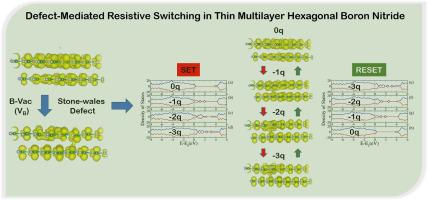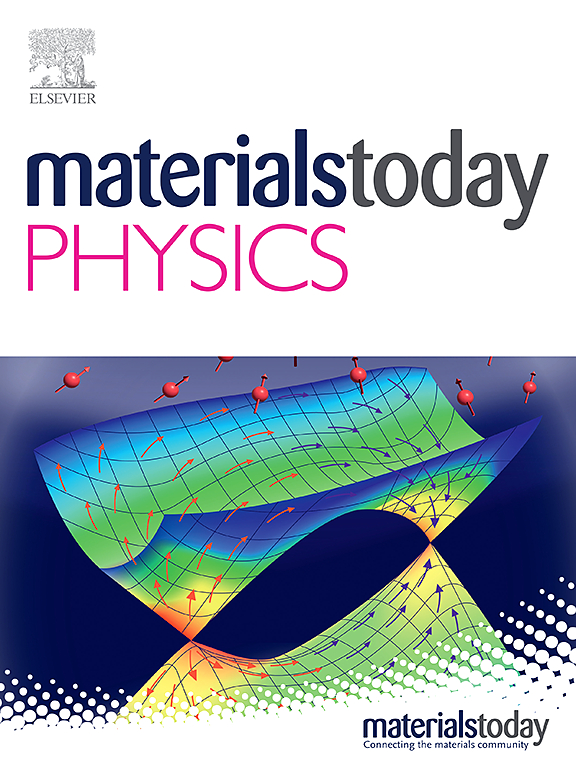Defect-mediated resistive switching in thin multilayer hexagonal boron nitride: A first principles study of charge state modulation
IF 10
2区 材料科学
Q1 MATERIALS SCIENCE, MULTIDISCIPLINARY
引用次数: 0
Abstract
Among the two-dimensional materials, hexagonal boron nitride (h-BN) has recently attracted much attention for resistive switching applications. The majority of the prior works focused on the switching mechanisms, which involve the diffusion of metal ions from the electrode into the boron vacancies (VB). Nonetheless, in such multi-layer systems, removing these metal ions during the RESET process is difficult and results in device failure. In this work, we explored resistive switching in h-BN, focusing on VB and Stone-Wales (SW) defects. SW defects act as simplified model for atomic rearrangements at grain boundaries. Our study investigate how these defects behave across different charge states, shedding light on their role in resistive switching mechanisms. The results of our Density Functional Theory (DFT) calculations showed the feasibility of SET and RESET operations in thin h-BN layers without the presence of metal atoms. We employed Nudged Elastic Band (NEB) calculations to show that SW defects greatly reduce the energy barrier for boron diffusion between h-BN layers and facilitates the formation of conductive bridges. These bridges, which are essential for SET and RESET processes, form and break dynamically in response to changes in charge states, particularly under the influence of negative charges. The stability of these conductive bridges was evaluated using ab initio Molecular Dynamic (AIMD) simulations. Moreover, electronic transport calculations performed using non-equilibrium Green's function (NEGF) revealed an Ion/Ioff ratio of 103. Our findings show that the combination of VB and SW defects is sufficient to enable resistive switching, making thin multilayer h-BN a promising candidate for threshold switching memristors.


薄多层六方氮化硼中缺陷介导的电阻开关:电荷态调制的第一性原理研究
在二维材料中,六方氮化硼(h-BN)在电阻开关方面的应用近年来备受关注。先前的大部分工作集中在开关机制上,涉及金属离子从电极扩散到硼空位(VB)。然而,在这种多层系统中,在RESET过程中去除这些金属离子是困难的,并且会导致设备故障。在这项工作中,我们探索了h-BN的电阻开关,重点是VB和Stone-Wales (SW)缺陷。SW缺陷是晶界原子重排的简化模型。我们的研究调查了这些缺陷在不同电荷状态下的行为,揭示了它们在电阻开关机制中的作用。我们的密度泛函理论(DFT)计算结果表明,在没有金属原子存在的薄h-BN层中进行SET和RESET操作是可行的。我们利用微推弹性带(Nudged Elastic Band, NEB)计算表明,SW缺陷极大地降低了硼在h-BN层之间扩散的能垒,促进了导电桥的形成。这些桥对于SET和RESET过程至关重要,随着电荷状态的变化,特别是在负电荷的影响下,它们会动态地形成和断开。利用从头算分子动力学(AIMD)模拟评价了这些导电桥的稳定性。此外,利用非平衡格林函数(NEGF)进行的电子输运计算显示离子/离合比为103。我们的研究结果表明,VB和SW缺陷的结合足以实现电阻开关,使薄多层h-BN成为阈值开关记忆电阻器的有希望的候选者。
本文章由计算机程序翻译,如有差异,请以英文原文为准。
求助全文
约1分钟内获得全文
求助全文
来源期刊

Materials Today Physics
Materials Science-General Materials Science
CiteScore
14.00
自引率
7.80%
发文量
284
审稿时长
15 days
期刊介绍:
Materials Today Physics is a multi-disciplinary journal focused on the physics of materials, encompassing both the physical properties and materials synthesis. Operating at the interface of physics and materials science, this journal covers one of the largest and most dynamic fields within physical science. The forefront research in materials physics is driving advancements in new materials, uncovering new physics, and fostering novel applications at an unprecedented pace.
 求助内容:
求助内容: 应助结果提醒方式:
应助结果提醒方式:


